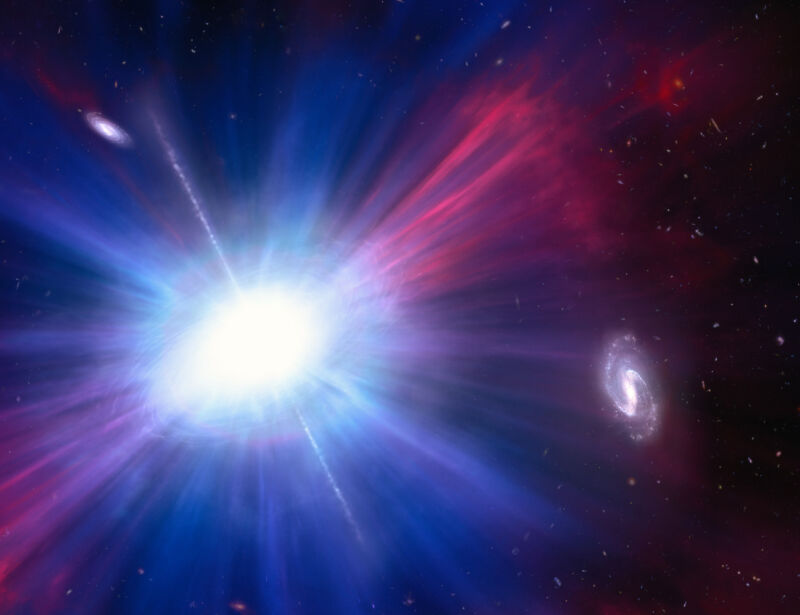
What is hundreds of billions of times more powerful than the Sun, flashes on repeat with intense bursts of light, and verges on defying the laws of physics? No, it’s not your neighbors’ holiday lights glitching again. It’s an LFBOT in the depths of space.
LFBOTs (Luminous Fast Blue Optical Transients) are already quite bizarre. They erupt with blue light, radio, X-ray, and optical emissions, making them some of the brightest explosions ever seen in space, as luminous as supernovae. It is no exaggeration that they give off more energy than hundreds of billions of stars like our own. They also tend to live fast, blazing for only minutes before they burn themselves out and fade into darkness.
LFBOTs are quite rare, and in many cases their sources are unidentified. But we’ve never seen anything with the intensity of an LFBOT named AT2022tsd—aka the “Tasmanian Devil.” Its strange behavior was caught by 15 telescopes and observatories, including the W.M. Keck Observatory and NASA’s Chandra Space Telescope. Like other phenomena of its kind, it initially emitted incredible amounts of energy and then dimmed. Unlike any other LFBOT observed before, however, this one seemed to come back from the dead. It flared again—and again and again.
That’s no supernova
The most common extragalactic transient luminous events, meaning flashes of light that evolve and vanish rapidly, are supernovae. The lifespan of their initial explosion is typically mere weeks. The “Tasmanian Devil” not only evolved faster than a supernova, but 14 individual flares were observed, lighting up over a stretch of several months, or about a hundred days. Even toward the end of the event, one flare was almost as bright as the original outburst of the transient. Scientists who investigated AT2022tsd still aren’t completely sure if they have accounted for every single flare. It is even more intense than another similar LFBOT that made headlines when it was discovered: AT2018cow aka “The Cow.”
“The multiwavelength properties of AT2022tsd are most similar to those of AT2018cow-like transients… suggesting a common origin,” an international team of researchers said in a study recently published in Nature.
AT2018cow displayed emissions comparable to (though not nearly as powerful as) those of AT2022tsd. “The Cow” could also be a hint to where these events get so much energy, since other similar transients are now thought to possibly be powered by a long-lasting energy source, though no such source has actually been found for either “The Cow” or the “Tasmanian Devil” yet. This hypothetical source could be a compact object that keeps releasing enormous amounts of energy through a jet or outflow. Some transients like AT2018cow have been traced to magnetars or black holes that keep accreting material and therefore are provided with a constant stream of energy.
Out of nowhere?
The outbursts of AT2022tsd had to have come from something, and researchers are still trying to figure out what. Supermassive black holes are a tempting option because of their massive amount of energy output. However, supermassive black holes also lurk at the centers of their galaxies. A closer look at “Tasmanian Devil” and where it was positioned in its galaxy determined it was not close enough to the galactic core to be fed by a supermassive black hole. Though that hypothesis is considered unlikely, scientists think there are still other possibilities.
“The possible power sources for the outflow are… a newborn neutron star or accretion onto a stellar-mass or intermediate-mass compact object,” they said in the same study. “In the latter case, the compact object could be a newly formed stellar-mass black hole.”
It is most likely that either a stellar-mass black hole, intermediate-mass black hole, or neutron star blasted out a phenomenon wild enough to be called the “Tasmanian Devil.” The LFBOT’s formation would probably have to have involved tidal disruption, which occurs when a star ventures too close to a black hole and is shredded by the black hole’s tidal forces. The tidal forces of neutron stars are also capable of disrupting stars. Devouring a star results in a huge input and output of energy for the black hole or neutron star, and that may explain what gave the “Tasmanian Devil” its wrath.
Could At2022tsd change our understanding of physics? Maybe. Both the extreme amount of energy it put out and the shorter bursts that continued for so long are testing the limits of physics because so many bursts of light being emitted during a short stretch of time would probably need to come from a relatively small source. But it’s not clear how we’re going to figure out what that source is.
Nature, 2023. DOI: 10.1038/s41586-023-06673-6
https://arstechnica.com/?p=1986340

